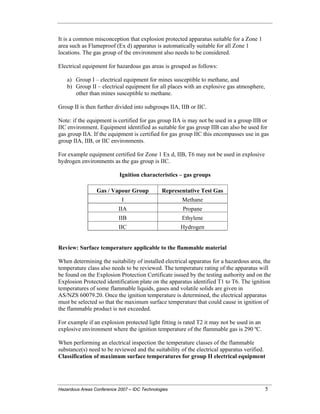Roar Solutions - The Facts
Roar Solutions - The Facts
Blog Article
An Unbiased View of Roar Solutions
In such an ambience a fire or explosion is feasible when three standard problems are met. This is usually referred to as the "unsafe area" or "burning" triangle. In order to safeguard installments from a potential surge a technique of analysing and identifying a possibly unsafe area is called for. The purpose of this is to ensure the proper choice and installation of equipment to inevitably stop a surge and to ensure safety of life.

(https://www.metal-archives.com/users/roarsolutions)
No tools should be mounted where the surface area temperature level of the tools is higher than the ignition temperature level of the offered danger. Below are some typical dust hazardous and their minimal ignition temperature. Coal Dust 380C 225C Polythene 420C (thaws) Methyl Cellulose 420C 320C Starch 460C 435C Flour 490C 340C Sugar 490C 460C Grain Dust 510C 300C Phenolic Material 530C > 450C Aluminium 590C > 450C PVC 700C > 450C Soot 810C 570C The likelihood of the danger being existing in a focus high sufficient to create an ignition will certainly vary from place to place.
In order to classify this threat an installment is divided into areas of risk depending upon the quantity of time the harmful exists. These locations are described as Areas. For gases and vapours and dirts and fibers there are three zones. Area 0 Area 20 A harmful environment is highly most likely to be existing and may exist for long periods of time (> 1000 hours annually) or also constantly Zone 1 Zone 21 A harmful ambience is possible but not likely to be existing for long durations of time (> 10 450 C [842 F] A classification of T6 means the minimal ignition temperature is > 85 C [185 F] Harmful location electric tools maybe designed for use in higher ambient temperatures. This would showed on the score plate e.g. EExe II C T3 Ta + 60C( This implies at 60C ambient T3 will certainly not be exceeded) T1 T1, T2, T3, T4, T5, T6 T2 T2, T3, T4, T5, T6 T3 T3, T4, T5, T6 T4 T4, T5, T6 T5 T5, T6 T6 T6 A T Course score of T1 implies the optimum surface area temperature generated by the instrument at 40 C is 450 C. Assuming the associated T Course and Temperature level score for the tools are ideal for the area, you can constantly utilize a tool with a much more stringent Division rating than required for the location. There isn't a clear response to this inquiry. It actually does depend upon the sort of devices and what fixings require to be accomplished. Devices with details test treatments that can't be executed in the field in order to achieve/maintain 3rd party ranking. Must come back to the manufacturing facility if it is prior to the equipment's solution. Area Repair Work By Authorised Personnel: Complicated testing may not be needed nonetheless certain procedures may need to be followed in order for the devices to preserve its third party rating. Authorised personnel have to be utilized to do the job correctly Repair service have to be a like for like replacement. New element must be taken into consideration as a direct substitute calling for no special testing of the equipment after the repair is total. Each piece of equipment with an unsafe ranking should be examined individually. These are detailed at a high degree below, however, for even more comprehensive info, please refer directly to the guidelines.
Rumored Buzz on Roar Solutions
The tools register is a thorough data source of equipment documents that consists of a minimum set of areas to determine each item's location, technological specifications, Ex classification, age, and environmental data. The ratio of Thorough to Shut inspections will be established by the Devices Danger, which is assessed based on ignition threat (the probability of a resource of ignition versus the likelihood of a combustible atmosphere )and the dangerous area category
( Zone 0, 1, or 2). Executing a robust Risk-Based Inspection( RBI )technique is vital for making certain conformity and security in managing Electric Devices in Hazardous Locations( EEHA).
Roar Solutions Fundamentals Explained

In regards to eruptive threat, an unsafe location is a setting in which an eruptive atmosphere is existing (or may be expected to be existing) in quantities that need special precautions for the building, installment and usage of equipment. eeha. In this article we discover the obstacles dealt with in the work environment, the danger control measures, and the called for proficiencies to function safely
It issues of modern life that we produce, store or handle a variety of gases or liquids that are regarded flammable, and a variety of dirts that are deemed flammable. These compounds can, in certain conditions, create explosive ambiences and these can have significant and unfortunate effects. The majority of us know with the fire triangle get rid of any among the three elements and the fire can not take place, yet what does this mean in the context of unsafe locations? When damaging this down into its most basic terms it is essentially: a combination of a certain quantity of release or leak of a specific substance or product, blending with ambient oxygen, and the existence of a source of ignition.
In a lot of instances, we can do little regarding the levels of oxygen in the air, yet we can have substantial influence on resources of ignition, for instance electric tools. Hazardous areas are recorded on the hazardous area category drawing and are determined on-site by the triangular "EX-SPOUSE" sign. Right here, amongst various other vital information, zones are divided right into 3 kinds depending upon the danger, the likelihood and period that an eruptive ambience will exist; Zone 0 or 20 is regarded one of Visit Your URL the most hazardous and Zone 2 or 22 is considered the least.
Report this page